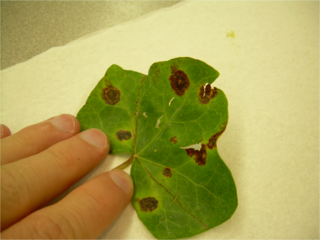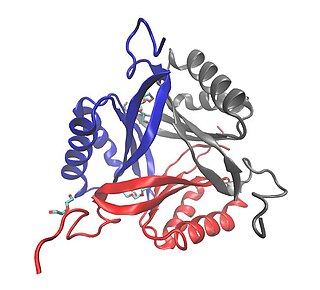
Fire blight, also written fireblight, is a contagious disease affecting apples, pears, and some other members of the family Rosaceae. It is a serious concern to apple and pear producers. Under optimal conditions, it can destroy an entire orchard in a single growing season.

Agrobacterium radiobacter is the causal agent of crown gall disease in over 140 species of eudicots. It is a rod-shaped, Gram-negative soil bacterium. Symptoms are caused by the insertion of a small segment of DNA, from a plasmid into the plant cell, which is incorporated at a semi-random location into the plant genome. Plant genomes can be engineered by use of Agrobacterium for the delivery of sequences hosted in T-DNA binary vectors.

Stewart's wilt is a bacterial disease of corn caused by the bacterium Pantoea stewartii. The disease is also known as bacterial wilt or bacterial leaf blight and has been shown to be quite problematic in sweet corn. The causal organism is a facultatively anaerobic, gram-negative, rod-shaped bacterium. The disease is endemic in the mid-Atlantic and Ohio River Valley regions and in the southern portion of the Corn Belt. Stewart's Wilt causes minor reductions in field corn yield, despite common occurrence, because most hybrids grown in the Midwest have adequate resistance. However, the disease can be problematic in seed production because many countries have restrictions on maize seed from areas where the Stewart's Wilt occurs.

Dickeya dadantii is a gram-negative bacillus that belongs to the family Pectobacteriaceae. It was formerly known as Erwinia chrysanthemi but was reassigned as Dickeya dadantii in 2005. Members of this family are facultative anaerobes, able to ferment sugars to lactic acid, have nitrate reductase, but lack oxidases. Even though many clinical pathogens are part of the order Enterobacterales, most members of this family are plant pathogens. D. dadantii is a motile, nonsporing, straight rod-shaped cell with rounded ends, much like the other members of the genus, Dickeya. Cells range in size from 0.8 to 3.2 μm by 0.5 to 0.8 μm and are surrounded by numerous flagella (peritrichous).

Xanthomonas campestris is a gram-negative, obligate aerobic bacterium that is a member of the Xanthomonas genus, which is a group of bacteria that are commonly known for their association with plant disease. The species is considered to be dominant amongst its genus, as it originally had over 140 identified pathovars and has been found to infect both monocotyledonous and dicotyledonous plants of economical value with various plant diseases. This includes "black rot" in cruciferous vegetables, bacterial wilt of turfgrass, bacterial blight, and leaf spot, for example.

Ralstonia solanacearum is an aerobic non-spore-forming, Gram-negative, plant pathogenic bacterium. R. solanacearum is soil-borne and motile with a polar flagellar tuft. It colonises the xylem, causing bacterial wilt in a very wide range of potential host plants. It is known as Granville wilt when it occurs in tobacco. Bacterial wilts of tomato, pepper, eggplant, and Irish potato caused by R. solanacearum were among the first diseases that Erwin Frink Smith proved to be caused by a bacterial pathogen. Because of its devastating lethality, R. solanacearum is now one of the more intensively studied phytopathogenic bacteria, and bacterial wilt of tomato is a model system for investigating mechanisms of pathogenesis. Ralstonia was until recently classified as Pseudomonas, with similarity in most aspects, except that it does not produce fluorescent pigment like Pseudomonas. The genomes from different strains vary from 5.5 Mb up to 6 Mb, roughly being 3.5 Mb of a chromosome and 2 Mb of a megaplasmid. While the strain GMI1000 was one of the first phytopathogenic bacteria to have its genome completed, the strain UY031 was the first R. solanacearum to have its methylome reported. Within the R. solanacearum species complex, the four major monophyletic clusters of strains are termed phylotypes, that are geographically distinct: phylotypes I-IV are found in Asia, the Americas, Africa, and Oceania, respectively.

Xanthomonas is a genus of bacteria, many of which cause plant diseases. There are at least 27 plant associated Xanthomonas spp., that all together infect at least 400 plant species. Different species typically have specific host and/or tissue range and colonization strategies.
Brenneria salicis is a Gram-negative bacterium that is pathogenic on plants.
Curtobacterium flaccumfaciens is a Gram-positive bacterium that causes disease on a variety of plants. Gram-positive bacteria characteristics include small irregular rods, lateral flagella, the ability to persist in aerobic environments, and cells containing catalase. In the interest of studying pathogenicity in plants, this species is broken down further into pathovars, which help to better describe the pathogen.
Xylophilus ampelinus is a species of bacteria that can cause plant disease. It is available from the NCPPB in the United Kingdom and other international culture collections such as ICMP in New Zealand, and LMG/BCCM in Belgium.

Bacterial wilt is a complex of diseases that occur in plants such as Cucurbitaceae and Solanaceae and are caused by the pathogens Erwinia tracheiphila, a gram-negative bacterium, or Curtobacterium flaccumfaciens pv. flaccumfaciens, a gram-positive bacterium. Cucumber and muskmelon plants are most susceptible, but squash, pumpkins, and gourds may also become infected.
Leifsonia xyli subsp. xyli is the bacterium that causes ratoon stunting disease, a major worldwide disease of sugarcane. It is Gram positive and grows slowly in the laboratory.

Xanthomonas campestris pv. vesicatoria is a bacterium that causes bacterial leaf spot (BLS) on peppers and tomatoes. It is a gram-negative and rod-shaped. It causes symptoms throughout the above-ground portion of the plant including leaf spots, fruit spots and stem cankers. Since this bacterium cannot live in soil for more than a few weeks and survives as inoculum on plant debris, removal of dead plant material and chemical applications to living plants are considered effective control mechanisms.

Bacterial Wilt of Carnations is a bacterial disease caused by the plant pathogen Paraburkholderia caryophylli. Previously, named Pseudomonas caryophilli, the pathogen is an aerobic gram negative bacteria known for only being capable of entering its host through wounds. Once inside the host, it colonizes the vascular system and roots causing symptoms such as, internal stem cracking, yellowing of the leaves, wilting, and the development of cankers. As a bacterial disease, Bacterial Wilt of Carnations can also be characterized by signs such as bacterial streaming, and bacterial ooze.
Rathayibacter toxicus is a phytopathogenic bacterium known for causing annual ryegrass toxicity (ARGT) commonly found in South and Western Australia.
Erwinia papayae is a bacteria species causing bacterial crown rot, or bacterial canker, a noteworthy and grave disease of papaya.

SbtB, which stands for sodium-bicarbonate-transporter B, is a protein found in bacteria. This small soluble protein has been classified as a new member of the P-II family that is involved in signal transduction. This protein has been demonstrated to participate in numerous processes including carbon sensing mechanisms in cyanobacteria.

Clavibacter insidiosus is a species of Clavibacter. It causes bacterial wilt, with its most notable host being Medicago sativa (alfalfa). Other species in the Medicago genus are also known to be hosts such as Medicago falcata. Additionally, Lotus corniculatus, Melilotus alba, Onobrychis viciifolia, and Trifolium sp. are known hosts.
Clavibacter nebraskensis is a species of bacteria in the genus Clavibacter. It causes wilt and blight in maize, called Goss's wilt.
Clavibacter sepedonicus is a species of bacteria in the genus Clavibacter. C. sepedonicus is a high-profile alien plant pathogen of A2 Quarantine status affecting only potatoes. It causes a disease in potatoes known as 'ring rot' due to the way it rots vascular tissue inside potato tubers It is present in parts of Europe but is under statutory control under 'Council Directive 93/85/EEC' of 4 October 1993 on the control of potato ring rot. This means that if an outbreak occurs, the outbreak must be controlled and if possible the disease has to be eradicated. If necessary, prohibitions are put into place to prevent further spread.












